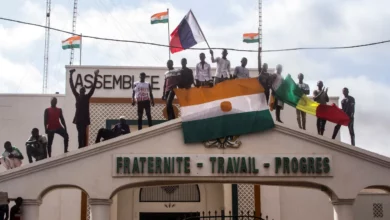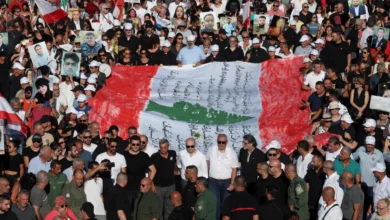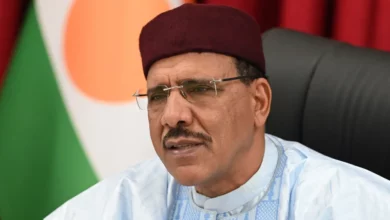A year, 11 months and 14 days have passed since the 25 January revolution and Egyptians are still taking to the streets and squares on Fridays, giving these days a name and making political and social demands.
But yesterday was one Friday with several names. It was the “Friday of the Red Card” in both Tahrir Square and Itihadiya Palace, but in Al-Azhar Mosque, it was “Friday of the Martyrs of Legitimacy” and in the Media Production City, it was “Friday of the Purging of the Media.” Outside of Cairo, masses protested in Alexandria against President Mohamed Morsy next to a presidential palace there, while in Sharqiya, where the president hails from, his opposition clashed with police next to his family house. In Mahalla, anti-Morsy protesters declared the industrial town an “independent zone” from the rule of the Brothers.
The day illustrated the growing rift between Morsy and the Brotherhood on one hand and the pro-democracy opposition on the other. The crisis was exacerbated by a bloody confrontation on Wednesday between the two blocs after loyal Islamists to Morsy attacked an opposition sit-in by the presidential palace. The sit-in was staged to demand the cancelation of a constitutional declaration through which Morsy claimed sweeping powers and the redrafting of a constitution that excluded most of the opposition.
Next to al-Azhar Mosque, crowds of Muslim Brothers joined the funeral of six martyrs who died in the Wednesday clashes. The supreme guide of the Brothers, Mohamed Badie, spoke after the Friday sermon, saying that spilling blood is haram (forbidden), while other Islamists who spoke at the stage said that the martyrs were killed by pro-democracy leader Mohamed ElBaradei and "his militias".
Amr Mansour, 25, a teacher and member of the Freedom and Justice Party, the Brotherhood’s political arm, took part in the funeral at Al-Azhar Mosque. “I am very sad that a political difference turns into this dramatic situation.”
Mansour stressed that “thugs” have infiltrated amidst the two parties, turned this dispute into hatred and used arms to kill the martyrs. “These are the same thugs who were behind the Mohamed Mahmoud Street violence, the cabinet clashes and the Port Said massacre (of football fans). If the Brothers intended violence, they wouldn’t have lost six martyrs,” he said.
As Mansour was telling Egypt Independent that he was sorry that his group had to forcibly disperse the sit-in of anti-Morsy protesters next to the presidential palace, others interrupted him to purport that the tents were empty and that the Brothers came only to dismantle them.
Ragab Sayed, who said he was present in the Wednesday clashes, contended that those taking part in the sit-in ran away when they heard of the approaching crowd of Morsy supporters. He added that the media coverage about tents being dismantled and people in there violently chased out of the palace area were acts by individual supporters of the president who were angered by the sit-in.
Like Mansour, Sayed added that if violence was intended from the side of the Brothers, there wouldn’t be martyrs from their side. He added that if the Brothers wanted to resort to violence, there would be many dead and injured people in the ranks of the opposition.
Sayed also said that the current dispute is of a political nature and has nothing to do with religion. He added that the opposition to the Brothers is behind this rift.
In the background, chants from the stage could be heard: “Bread, freedom, Islamic Sharia,” a variation of the 25 January 2011 seminal chant “Bread, Freedom, Social Justice.”
Many protesters spoke of a conspiracy aimed at taking over the presidential palace and toppling Morsy from there and this is was prompted the Brothers to go there to secure the building, especially that the police refrained from barring the opposition from camping out there. “This is better than if the presidential guards came out and killed one of those in the sit-in. That would have mobilized the whole country against the president who will be accused of killing protesters,” a Muslim Brother who preferred to remain anonymous told Egypt Independent.
FJP leader Mohamed al-Beltagy eventually appeared on the stage to call on everyone to leave to repel any accusations that the Brothers are planning violent acts. “The zero hour to take to the streets in known to all Egyptians and it will take place if there is any attempt to break into the presidential palace or Maspero state television building. If the state apparatus doesn’t move, waves of people will do it in defense of legitimacy. Today, as we mourn our martyrs, we also announce that we are all ready to be martyrs if anyone tries to challenge our legitimacy.”
Away from Al-Azhar Mosque and in Tahrir Square, the anti-Morsy sit-in was continuing, with tents inside the roundabout, street vendors and protesters all around it. Some marches reached the square following the Friday prayers, but it was not totally filled as more crowds flocked to the Ittihadiya presidential palace, expressing the same demands: The cancelation of the constitutional declaration and the reworking of the constitution through a more representative assembly.
May Madkour came to Tahrir with her two sisters and their children and described herself as belonging to the “couch party”, the common label for people refraining from political participation and protests. Madkour had voted for Amr Moussa, a former figure of the Mubarak regime, in the presidential elections’ first round and Ahmad Shafiq, Mubarak’s last prime minister, in the second round.
She said that she does not want Morsy to go or the regime to fall. “The people did not protest against the president in his first three months. But he is the one who fueled their anger with his stubborn attitude that is reminiscent of the Mubarak days. The president should respect the will of his people,” she said.
Madkour denounced the president’s call for a dialogue with other political forces which he announced in his much awaited televised speech on Thursday. She said that she supports the National Salvation Front, which was formed by opposition leaders in the wake of the current conflict, in its rejection of a dialogue with no set agenda or conditions from the president.
The square was filled with signs reading “no to the constitutional declaration" and "no to the referendum on the constitution."
Eventually a march from the Journalists Syndicate arrived to the square, with pictures of al-Husseiny Abu Deif, the reporter from Al-Fajr newspaper who lies on a hospital bed in a precarious condition as he was covering Wednesday’s clashes between Morsy supporters and their opponents.
Mohamed Abdel Fattah, a journalist taking part in the march, said that Abu Deif was one of the most active journalists partaking in all political events and particularly journalists-related actions. “I wasn’t close to Husseiny until two weeks ago when we were together in a photojournalism training. He was too engaged with the political scene that he had to miss the training sessions several times.”
On his Twitter account, Abdel Fattah posted a picture of the march from the Journalists Syndicate and wrote, “This is the first time there is a march of journalists and Husseiny is not there.” Besides working in Al-Fajr newspaper, Husseiny was also a member of the Kifaya Movement, which was formed in 2005 to demand an end to Mubarak's rule.
And as Tahrir was filling up, Islamist protesters flocked to the Media Production City, including members of Salafi groups and Hazemoun (supporters of former presidential candidate and Islamist preacher Hazem Salah Abu Ismail), to demand the purging of the media. They have set up tents with the aim of starting an open-ended sit-in. The protesters condemned what they called a media bias to secular voices.
In the far east of the city, crowds gathered around the presidential palace, marching from different parts of Cairo. Families and children were walking around the area, jubilantly chanting, “I am not an atheist or an apostate, but down with the supreme guide” and “Egypt is too big for you, Mr. president.”
The palace was initially shielded with barbed wires and military tanks following Wednesday’s clashes. However, protesters broke the barbed wires and managed to get to the palace without much resistance from the surrounding presidential guards and military personnel. When the Muslim Brothers saw this happening, they started a gathering in the Rabaa Adawiya mosque, which is at some kilometers away from the palace, threatening of marching to the palace if there is any attempt to break in.
But at the palace, all what was happening once protesters got close, was to attack its walls with anti-regime graffiti.




